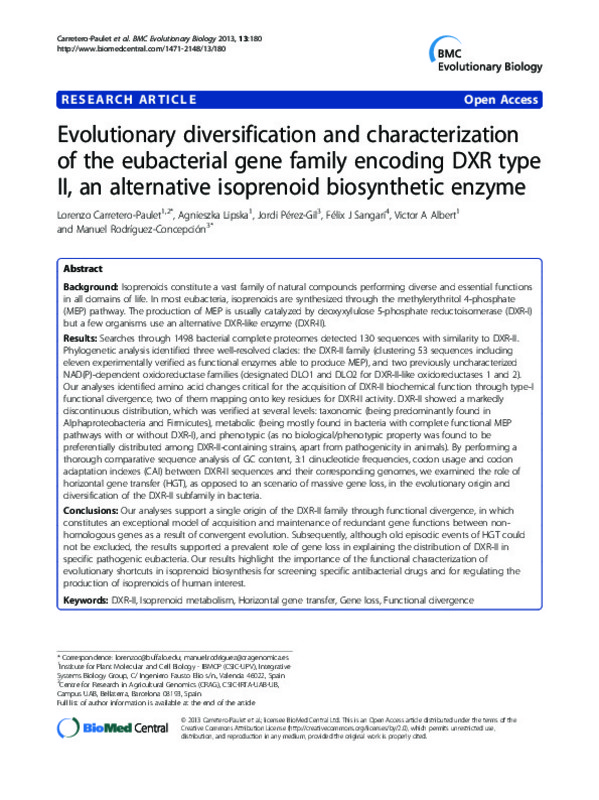JavaScript is disabled for your browser. Some features of this site may not work without it.
Buscar en RiuNet
Listar
Mi cuenta
Estadísticas
Ayuda RiuNet
Admin. UPV
Evolutionary diversification and characterization of the eubacterial gene family encoding DXR type II, an alternative isoprenoid biosynthetic enzyme
Mostrar el registro sencillo del ítem
Ficheros en el ítem
| dc.contributor.author | Carretero Paulet, Lorenzo
|
es_ES |
| dc.contributor.author | Lipska, Agnieszka
|
es_ES |
| dc.contributor.author | Perez-Gil, J.
|
es_ES |
| dc.contributor.author | Sangari, J.
|
es_ES |
| dc.contributor.author | Albert, VA
|
es_ES |
| dc.contributor.author | Rodriguez-Concepción, M
|
|
| dc.date.accessioned | 2016-05-12T10:44:34Z | |
| dc.date.available | 2016-05-12T10:44:34Z | |
| dc.date.issued | 2013-09-03 | |
| dc.identifier.issn | 1471-2148 | |
| dc.identifier.uri | http://hdl.handle.net/10251/63963 | |
| dc.description.abstract | [EN] Background: Isoprenoids constitute a vast family of natural compounds performing diverse and essential functions in all domains of life. In most eubacteria, isoprenoids are synthesized through the methylerythritol 4-phosphate (MEP) pathway. The production of MEP is usually catalyzed by deoxyxylulose 5-phosphate reductoisomerase (DXR-I) but a few organisms use an alternative DXR-like enzyme (DXR-II). Results: Searches through 1498 bacterial complete proteomes detected 130 sequences with similarity to DXR-II. Phylogenetic analysis identified three well-resolved clades: the DXR-II family (clustering 53 sequences including eleven experimentally verified as functional enzymes able to produce MEP), and two previously uncharacterized NAD(P)-dependent oxidoreductase families (designated DLO1 and DLO2 for DXR-II-like oxidoreductases 1 and 2). Our analyses identified amino acid changes critical for the acquisition of DXR-II biochemical function through type-I functional divergence, two of them mapping onto key residues for DXR-II activity. DXR-II showed a markedly discontinuous distribution, which was verified at several levels: taxonomic (being predominantly found in Alphaproteobacteria and Firmicutes), metabolic (being mostly found in bacteria with complete functional MEP pathways with or without DXR-I), and phenotypic (as no biological/phenotypic property was found to be preferentially distributed among DXR-II-containing strains, apart from pathogenicity in animals). By performing a thorough comparative sequence analysis of GC content, 3: 1 dinucleotide frequencies, codon usage and codon adaptation indexes (CAI) between DXR-II sequences and their corresponding genomes, we examined the role of horizontal gene transfer (HGT), as opposed to an scenario of massive gene loss, in the evolutionary origin and diversification of the DXR-II subfamily in bacteria. Conclusions: Our analyses support a single origin of the DXR-II family through functional divergence, in which constitutes an exceptional model of acquisition and maintenance of redundant gene functions between nonhomologous genes as a result of convergent evolution. Subsequently, although old episodic events of HGT could not be excluded, the results supported a prevalent role of gene loss in explaining the distribution of DXR-II in specific pathogenic eubacteria. Our results highlight the importance of the functional characterization of evolutionary shortcuts in isoprenoid biosynthesis for screening specific antibacterial drugs and for regulating the production of isoprenoids of human interest. | es_ES |
| dc.description.sponsorship | We thank all our laboratory members for stimulating discussions and suggestions. We thank Derek Taylor and Mario A Fares for critical reading of the manuscript and helpful comments. Financial support for this research was provided by the Spanish Ministerio de Ciencia e Innovacion (grants BIO2011-23680 to MRC and BFU2011-25658 to FJS) and Generalitat de Catalunya (2009SGR-26 and XRB) to MRC. | |
| dc.language | Inglés | es_ES |
| dc.publisher | BioMed Central | es_ES |
| dc.relation.ispartof | BMC Evolutionary Biology | es_ES |
| dc.rights | Reconocimiento (by) | es_ES |
| dc.subject | DXR-II | es_ES |
| dc.subject | Isoprenoid metabolism | es_ES |
| dc.subject | Horizontal gene transfer | es_ES |
| dc.subject | Gene loss | es_ES |
| dc.subject | Functional divergence | es_ES |
| dc.title | Evolutionary diversification and characterization of the eubacterial gene family encoding DXR type II, an alternative isoprenoid biosynthetic enzyme | es_ES |
| dc.type | Artículo | es_ES |
| dc.identifier.doi | 10.1186/1471-2148-13-180 | |
| dc.relation.projectID | info:eu-repo/grantAgreement/MICINN//BIO2011-23680/ES/MODULACION AMBIENTAL DE LA BIOSINTESIS DE CAROTENOIDES EN PLANTAS/ | es_ES |
| dc.relation.projectID | info:eu-repo/grantAgreement/Generalitat de Catalunya//2009 SGR 26/ | es_ES |
| dc.relation.projectID | info:eu-repo/grantAgreement/MICINN//BFU2011-25658/ES/REGULACION DE LA VIRULENCIA DE BRUCELLA ABORTUS MEDIADA POR HFQ/ | |
| dc.rights.accessRights | Abierto | es_ES |
| dc.contributor.affiliation | Universitat Politècnica de València. Instituto Universitario Mixto de Biología Molecular y Celular de Plantas - Institut Universitari Mixt de Biologia Molecular i Cel·lular de Plantes | es_ES |
| dc.description.bibliographicCitation | Carretero Paulet, L.; Lipska, A.; Perez-Gil, J.; Sangari, J.; Albert, V.; Rodriguez-Concepción, M. (2013). Evolutionary diversification and characterization of the eubacterial gene family encoding DXR type II, an alternative isoprenoid biosynthetic enzyme. BMC Evolutionary Biology. 13(180):1-18. https://doi.org/10.1186/1471-2148-13-180 | es_ES |
| dc.description.accrualMethod | S | es_ES |
| dc.relation.publisherversion | http://dx.doi.org/10.1186/1471-2148-13-180 | es_ES |
| dc.description.upvformatpinicio | 1 | es_ES |
| dc.description.upvformatpfin | 18 | es_ES |
| dc.type.version | info:eu-repo/semantics/publishedVersion | es_ES |
| dc.description.volume | 13 | es_ES |
| dc.description.issue | 180 | es_ES |
| dc.relation.senia | 261356 | es_ES |
| dc.identifier.pmid | 24004839 | en_EN |
| dc.identifier.pmcid | PMC3847144 | en_EN |
| dc.contributor.funder | Ministerio de Ciencia e Innovación | |
| dc.contributor.funder | Generalitat de Catalunya |








